What Is Headless Commerce: Benefits, Real-World Examples, and Best Platforms
Fast updates… Seamless experiences… Personalisation that actually works…
That’s what modern eCommerce demands, but most platforms just aren’t built for it. You want to launch something new or improve the buying journey, but instead, you’re stuck in long dev cycles, platform limitations, and fragile templates.
If you’ve ever had to delay a feature launch just because the backend couldn’t handle it, you already know the problem.
This is exactly why headless commerce is gaining serious traction.
It’s a better, more flexible way to build and scale eCommerce. One that gives your team more freedom to create, experiment, and move faster without dragging your entire system down with every change.
What is Headless Commerce?
Headless commerce involves separating the front end of your site (what customers see and interact with) from the back end (where all the data, logic, and systems live).
This decoupling gives you complete control over the customer experience. You can design your storefront however you like, build custom apps, and test new sales channels, all without touching the backend.
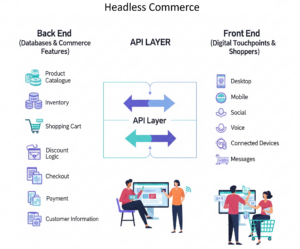
Here’s why that matters:
- You’re not tied to platform templates or rigid page builders
- Developers can work on the front end without breaking backend logic
- You can scale faster, adapt quicker, and offer consistent UX across devices
- You can integrate best-in-class tools through APIs without restrictions
It’s a more agile setup that lets you evolve your experience without constantly battling technical debt. If you want to stop building around your platform’s limitations and start building around your customers, this is the model to explore.
Composable Commerce vs Headless Commerce
The two terms are often used interchangeably, but they’re not exactly the same.
Headless commerce
refers specifically to decoupling the front end (your storefront) from the back end (your eCommerce engine). It gives you the freedom to design unique customer experiences without being tied to how your backend works.
Composable commerce
takes that idea further. Instead of using one platform for everything, you build your tech stack by combining individual services, like payments, product search, CMS, and checkout, each chosen based on what fits your business best.
In short:
- Headless separates the front end from the back end.
- Composable breaks the entire system into modular, interchangeable parts.
Most composable setups are headless, but not all headless setups are fully composable!
How Headless Commerce Works
To understand how headless commerce actually works, you need to look at what’s happening under the hood. It all comes down to decoupling, i.e. separating the front end (what customers see) from the back end (where all the logic and data lives).
Here’s how the setup breaks down…
Front end
This is your storefront or customer-facing layer. It could be a website, mobile app, smart mirror, voice assistant, or even a kiosk. With headless, this front end is built independently using modern frameworks like React, Vue, or Next.js.
Back end
This is where the engine runs. It handles things like product data, customer information, inventory, payment processing, and order management. The backend is typically powered by an eCommerce platform or microservices.
APIs (Application Programming Interfaces)
These are the crucial link. APIs act as the bridge between the front and back end. When a user interacts with your site, such as adding a product to their cart or filtering results, the front end sends a request through the API, which fetches data from the back end and returns it instantly.
Headless Commerce Market Size
At present, the headless commerce market size is $1.74 billion, and it’s expected to reach $7.16 billion by 2032.
This means the market is expected to grow at a 22.4% CAGR over the next seven years.
Headless Commerce vs Traditional Commerce
If you’re trying to figure out whether headless commerce is worth it, the best place to start is by comparing it to the traditional setup.
Traditional platforms bundle everything together: the front end, the back end, and all the logic in between. That might sound neat and tidy, but in reality, it often slows things down, limits flexibility, and makes customisation painful.
Headless changes that. Here’s how the two approaches stack up:
1. Faster to launch & faster to adapt
In a traditional setup, most of your time and budget go into backend development. Want to change something on the front end? You’ll probably need to touch the backend too. That means longer timelines and more complexity, even for small updates.
With headless, your backend stays stable while your front end moves as fast as you need it to. Whether you’re testing a new layout, rolling out a campaign, or launching in a new market, the go-to-market time is dramatically shorter.
2. Complete control over the customer experience
Traditional platforms usually come with built-in templates, themes, and rigid admin panels. They may be great for getting started, but not so great when you want to stand out or offer a more tailored experience.
Headless gives you full creative control. You can personalise the customer journey at every touchpoint; not just what users see, but how the experience feels. Whether that’s adapting content for different devices, localising by region, or designing admin tools that work better for your team, headless lets you build what actually fits your business, not someone else’s roadmap.
3. Developers have the freedom to build what they need
Most monolithic eCommerce platforms tie your front-end developers’ hands. If they want to change the user experience, they often need to work around legacy systems or update backend logic, which isn’t always in their wheelhouse.
With headless, the front end and back end talk to each other through APIs. That means developers can focus on building fast, responsive, on-brand experiences without needing to touch backend code every time. It’s cleaner, more efficient, and way more scalable.
Benefits of Headless Commerce
Now that you have a good understanding of the headless commerce meaning and how it compares to traditional commerce, the question becomes, what are the benefits of headless commerce?
1. Speed and agility – Teams move faster, with less friction
In traditional commerce, every front-end update can turn into a development bottleneck. Something as small as a UI tweak or a new campaign landing page might require backend changes, QA cycles, and cross-team coordination. That slows everything down.
Headless breaks that pattern. Front-end and back-end teams can work independently, often in parallel, which shortens delivery cycles dramatically. For teams managing multiple sites, regions, or product lines, that speed becomes a real competitive advantage.
It’s also worth noting that headless architecture supports microservices and modular builds. That means you don’t need to rebuild everything when making updates. You can ship faster, test more often, and iterate without the overhead of a monolithic system.
2. True omnichannel commerce
Let’s be honest, most “omnichannel” strategies are stitched together across disconnected systems. Customers start a journey in one channel and hit a wall when switching to another. That’s a conversion killer.
Headless changes the model. Because the backend is decoupled, you can deliver a consistent UX across every digital touchpoint. We’re talking web, mobile, app, in-store, kiosk, even voice or wearable interfaces. Your customer data, product catalogue, and content live in one place, and APIs push it wherever it needs to go.
And when a new channel pops up? You don’t wait for your platform to build a native integration; your team can build the front-end experience internally and launch on your own terms.
3. Integrations are built into the design
Most eCommerce teams are using a growing stack of tools: CDPs, CRMs, CMS platforms, analytics layers, personalisation engines, and more. Traditional platforms often struggle to keep up or require clunky workarounds that slow things down.
Headless platforms are designed with integration in mind. APIs aren’t an add-on; they’re foundational. That means your architecture is flexible from the start, and your tech stack can evolve without being locked into a single vendor ecosystem.
Need to swap out your CMS or experiment with a new search engine? You can. Want to centralise customer data in a CDP or power personalisation with machine learning? The backend stays stable, and you just plug in the tools that make sense.
4. Customisation that actually scales
You don’t just want a site that looks unique; you need one that works the way your business works.
With a traditional platform, customisation often means hacking around templates, pushing the limits of the CMS, or maintaining forked codebases that break with every update.
Headless lets you build your UX layer from scratch or extend it as needed, without touching the underlying infrastructure. That means no more working against your platform, and no more compromise between custom features and long-term maintainability.
Even better, your personalisation efforts become more powerful. With a clean API layer and access to unified customer data, you can create channel-specific experiences, dynamic content, and targeted product recommendations that adapt in real time.
Disadvantages of Headless Commerce
Headless commerce offers a lot of freedom and flexibility, but it’s not the right fit for every business. Like any architecture decision, it comes with trade-offs. Here’s what to consider before going headless.
1. Higher upfront complexity
You’re not getting an all-in-one package. With headless, you’re essentially building a custom stack, choosing your front-end framework, backend tools, and API connections. That setup takes time, planning, and technical expertise.
If your team isn’t already familiar with modern development frameworks and APIs, you may need to bring in specialist support or expand your internal capabilities.
2. More development resources are required
Headless gives you control, but it also means more responsibility. You’ll need developers to manage the front end, maintain integrations, handle API changes, and keep things running smoothly.
If you’re used to drag-and-drop themes or visual builders, moving to a headless model can feel like a big leap.
3. Ongoing maintenance
With traditional platforms, most of the infrastructure is managed for you. In a headless setup, your team is responsible for managing multiple services, monitoring performance, and ensuring everything stays in sync.
It’s manageable with the right setup, but it adds technical overhead compared to using a single, monolithic platform.
4. Costs can scale with complexity
Headless commerce isn’t necessarily more expensive, but it can be, especially if you’re using multiple best-in-class tools (CMS, CDP, search, etc.) and maintaining a custom front end.
It’s worth weighing these costs against the performance, flexibility, and scalability gains. For some brands, the ROI is clear. For others, an all-in-one platform might still make more sense. We can help you figure out what makes the most sense for your budget.
Headless eCommerce Real-world Examples
To give you some inspiration, we’ve gathered some headless eCommerce examples:
ASICS – Going headless to deliver speed and localisation

ASICS moved to a headless setup using Contentstack (CMS), commercetools (backend), and Vue Storefront (front end). The goal was clear: reduce page load times and improve localisation across global markets.
By decoupling the tech stack, they were able to deliver region-specific content and campaigns faster, while keeping performance consistent worldwide. The result? Faster launches, stronger UX, and a framework that supports future growth.
Rebag – Luxury resale with a tailored shopping journey

Rebag, a luxury resale platform for designer handbags, adopted a headless architecture to better reflect its high-end positioning and deliver a more curated experience.
They used a headless CMS to manage editorial-style content and paired it with a flexible storefront that could evolve quickly, supporting both content-heavy product storytelling and advanced filtering. This allowed them to merge editorial and eCommerce in a way that felt native to their brand.
Burrow – Personalised furniture shopping with React and Shopify Plus

Burrow needed a site that could handle complex product configurations, personalised experiences, and fast load times. They built a custom React front end on top of Shopify Plus, using the Storefront API.
The headless setup gave them full control over design and UX, helping them create a dynamic, app-like interface where users could visualise custom furniture setups, without sacrificing speed or mobile performance.
Cole Haan – Future-proofing for omnichannel and mobile

Cole Haan adopted a headless strategy to deliver consistent shopping experiences across mobile, desktop, and in-store displays. They combined a React-based front end with a best-of-breed backend stack including Salesforce Commerce Cloud and Contentstack.
The move helped them simplify omnichannel execution and deliver more cohesive, high-performance experiences, especially as mobile traffic grew.
Best headless eCommerce platforms in 2025
There’s no one-size-fits-all solution when it comes to headless commerce platforms. The right choice depends on your business size, technical stack, and how much control you want over the front and back end.
Here’s a breakdown of some of the best headless commerce platforms on the market today, what they offer, and who they’re best for.
Shopify Plus
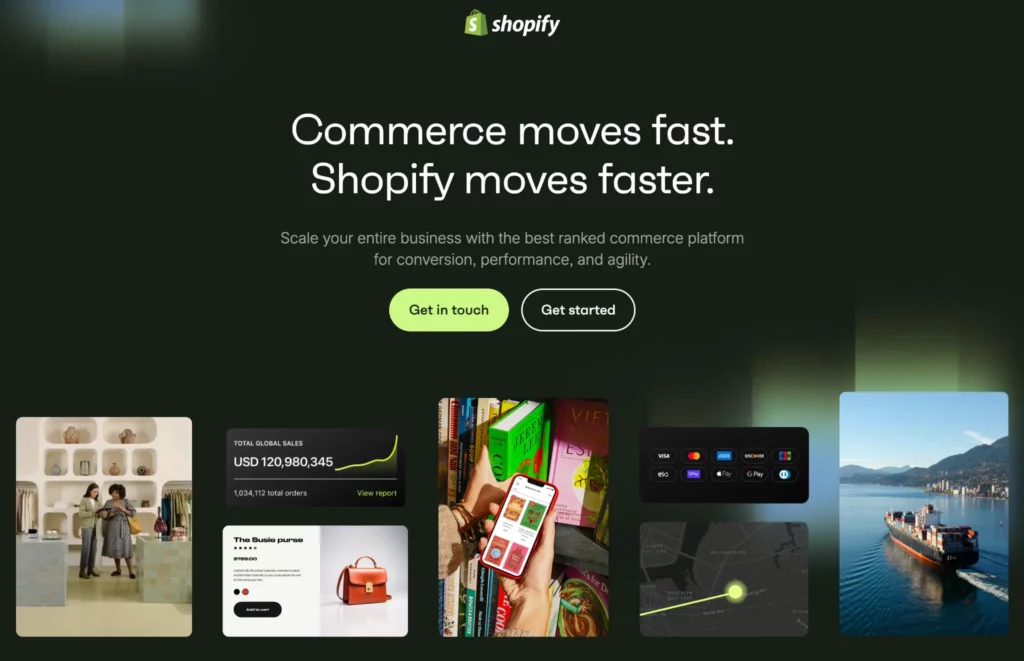
Best for brands that want speed, scale, and strong ecosystem support
Shopify’s headless offering via Shopify Plus makes it easy to decouple your front end while keeping the stability and ease of use Shopify is known for. It’s ideal for fast-growing brands that need to publish across multiple touchpoints, such as mobile apps, smart devices, and digital signage, without rebuilding from scratch.
You get access to Storefront API, flexible CMS integrations, and tools like Hydrogen (Shopify’s React-based front-end framework) for full creative control. The trade-off? It’s not as customisable on the backend as some open-source solutions, but for most, that’s a worthwhile compromise for the speed and reliability.
BigCommerce
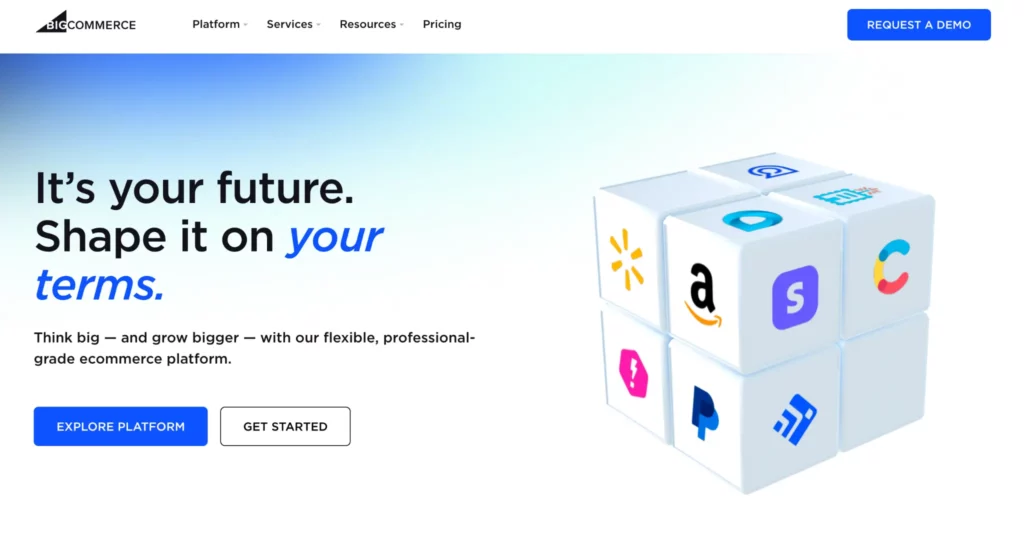
Great for mid-sized to enterprise brands that want flexibility without going fully custom
BigCommerce takes a more open approach to headless. It’s front-end agnostic, meaning you can use any framework you like, be it React, Vue, or Next.js, while managing your catalogue, checkout, and promotions through BigCommerce’s backend.
It integrates well with popular CMS tools and supports multi-storefront setups. This makes it a wise choice for teams who want flexibility but still appreciate having an out-of-the-box commerce engine running behind the scenes.
Commerce Layer
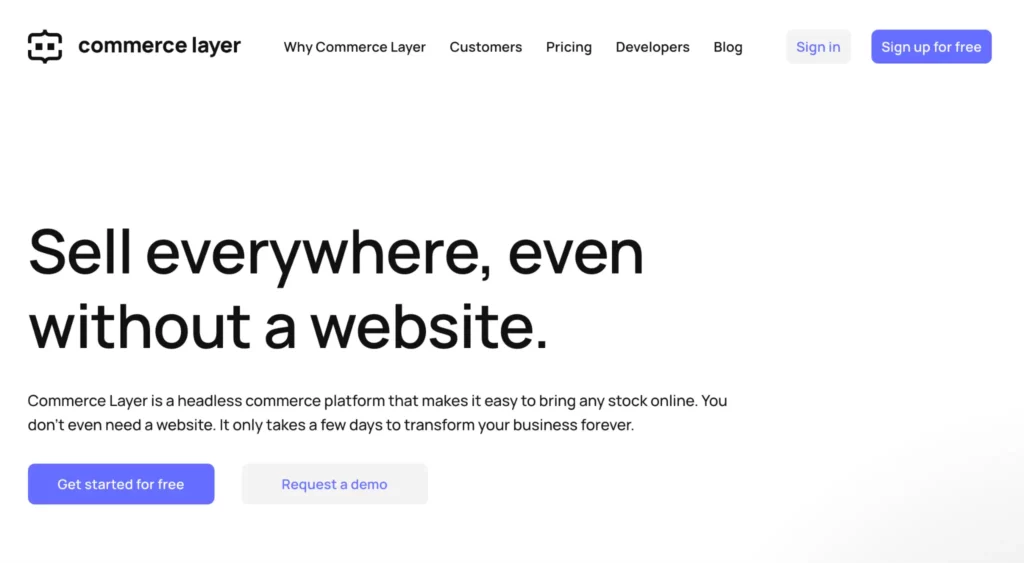
Best for global brands with complex pricing and localisation needs
Commerce Layer is a true API-first, headless commerce platform built for brands selling across multiple regions and channels. It handles pricing, inventory, and orders globally, and was designed from the ground up for performance and scalability.
If you’re running a multi-country operation with different languages, currencies, tax models, and fulfilment logic, this is the kind of platform that can support that out of the box, without becoming a maintenance nightmare.
Kontent.ai
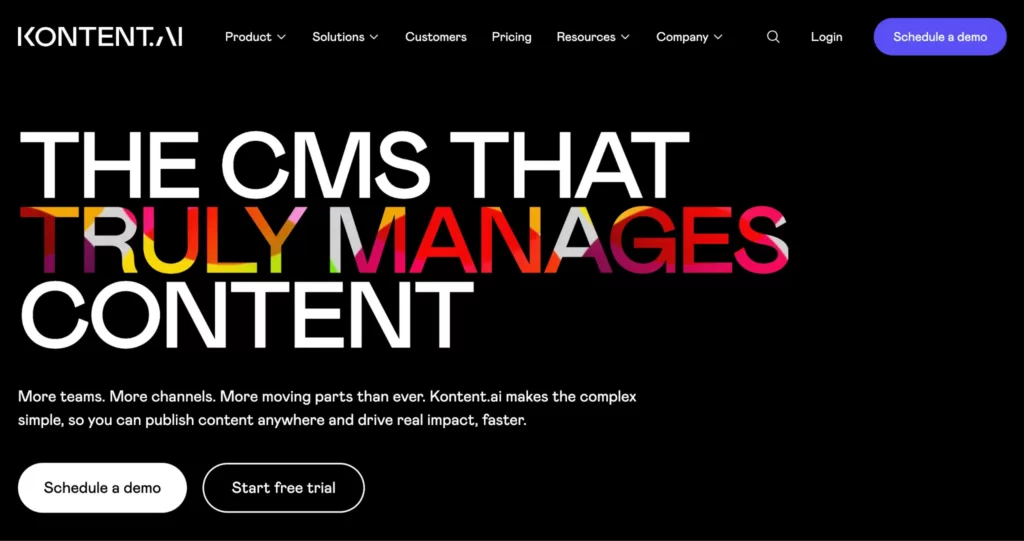
Ideal for content-heavy brands that need CMS-first workflows
Kontent.ai is a headless CMS, not a commerce platform itself, but it’s often used as part of a headless digital commerce stack for brands that need rich content delivery at scale. It works well alongside custom front ends and commerce back ends (like Commercetools or BigCommerce) where content is a major part of the shopping journey.
It’s particularly useful for teams who want enterprise-level governance, workflows, and localisation tools, especially across multiple sites or regions.
Commercetools
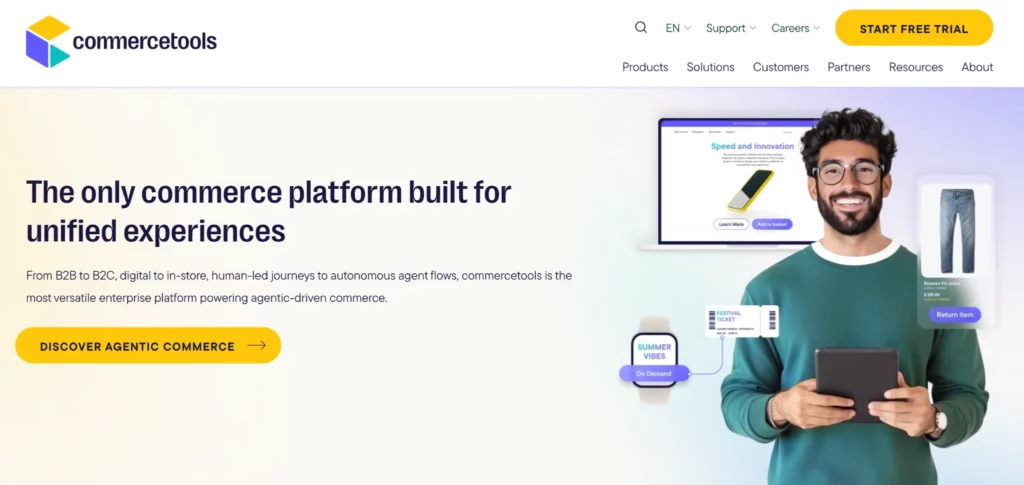
Best for enterprise teams that need full customisation and MACH architecture
Commercetools is one of the most technically robust headless commerce platforms on the market. It follows the MACH principles (Microservices, API-first, Cloud-native, Headless), giving engineering teams total control to build a commerce experience exactly how they want it, with no template or stack limitations.
It’s not plug-and-play, and it’s not meant to be. But if you have an experienced dev team and a complex, global commerce strategy, this platform gives you the flexibility to build a truly tailored, future-proof infrastructure.
Is Headless Commerce Right for You?
It’s not hard to see why headless commerce has become a standout choice. If you’re looking for speed, flexibility, and control over your eCommerce experience, headless might be the move that changes everything.
It comes down to staying competitive; being able to launch updates fast, meeting your customers wherever they are, and building an online experience that actually reflects your brand, not your platform’s limitations.
You’ve seen how real brands are already using it to improve speed, simplify multi-device shopping, and gain serious ground in their markets. You’ve also got options, from lightweight solutions to full-scale enterprise setups, so you’re not limited by where your business is right now.
Want to explore headless for your business?
Here at Appnova, we help brands build future-ready eCommerce experiences using the right headless tools, platforms, and strategies.
If you’re ready to break free from platform limitations and create something more flexible, we’d love to chat.
FAQs About Headless Commerce
Who is headless commerce best for?
Headless is ideal for brands that need more flexibility, especially those running multiple sites, selling across channels, or pushing custom experiences. It suits mid-size to enterprise teams with strong dev resources.
Is headless commerce good for SEO?
Yes, headless can be great for SEO. You get full control over performance, structure, and metadata. But it’s manual, so you’ll need developers to handle SEO basics like sitemaps and structured data.
Does headless commerce mean no CMS?
No, you can still use a CMS with headless. In fact, many teams use headless CMS platforms like Contentful, Sanity, or Kontent.ai to manage and deliver content across all channels.
Summary
As you can see, headless eCommerce offers a number of benefits for businesses today. We hope the examples provide you with the inspiration you need to get started. And, don’t forget that there are some fantastic headless eCommerce platforms on the market too.
Subscribe To Us
Our Services
Categories
Subscribe To Us
Contributors
Categories

This website uses cookies so that we can provide you with the best user experience possible. Cookie information is stored in your browser and performs functions such as recognising you when you return to our website and helping our team to understand which sections of the website you find most interesting and useful. Third party cookies such as Google Analytics is also used on this site to provide analytics in order to better understand the user engagement on our site.
You can adjust all of your cookie settings by navigating the tabs on the left hand side.
Strictly Necessary Cookie should be enabled at all times so that we can save your preferences for cookie settings.
If you disable this cookie, we will not be able to save your preferences. This means that every time you visit this website you will need to enable or disable cookies again.







0.Comments